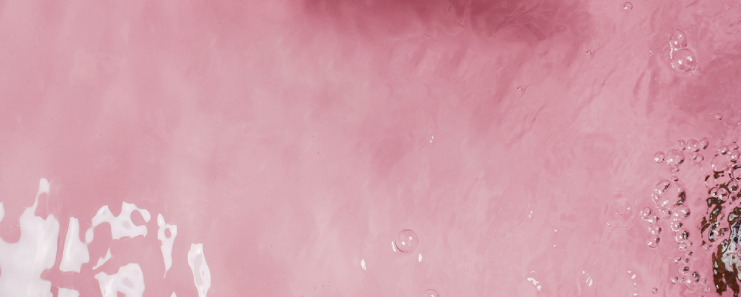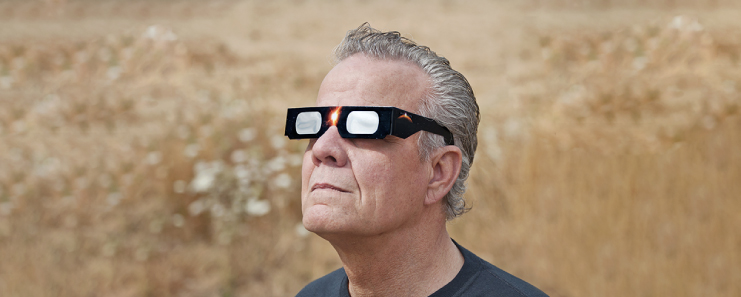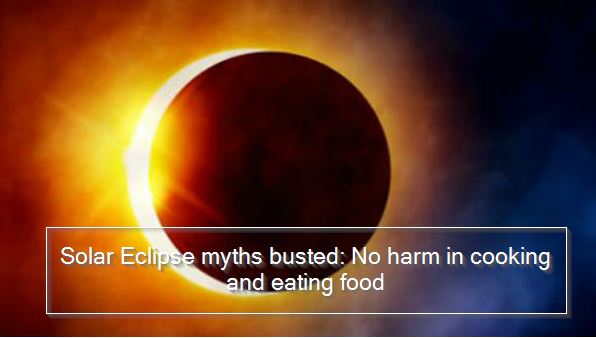Solar Eclipse myths busted: No harm in cooking and eating food
Solar eclipse: Facts or myths
Here are some of the most-common warnings you would have come across regarding solar eclipses:
1. Have a bath before and after a solar eclipse
2. Eat at least two hours before an eclipse
3. Eat fresh food prepared after the solar eclipse ends.
4. Refrain from looking at the sun directly during an eclipse
5. Avoid going outdoors during an eclipse
6. Meditate during a solar eclipse
The surya grahan or annular solar eclipse is on December 26, 2019. It is called an annular solar eclipse because at the distance that the moon is from the sun, its diameter appears smaller than the sun’s. This results in it blocking most of the sun’s light making the sun look like a ring (annulus). This phenomenon will be visible from many parts of West and East Asia, India and Pakistan.
1. Have a bath before and after the eclipse
Partially true
Pregnant women are advised to take a cold water bath after a solar eclipse. This is to safeguard them from any harmful effects of growth of microorganisms. Cold water helps stimulate the vagus nerve (connecting the brain to the abdomen), which is responsible for the rest and digest system or parasympathetic nervous system. Thus, this helps in digestion. It also helps relax both the mind and the body.

2. Eat at least two hours before an eclipse
Fact
There are a couple of reasons for this.
The sun’s blue and ultraviolet radiations act as natural disinfectants. It so happens that during a solar eclipse their intensity and wavelength are not the same as on other days. As a result, the rays do not perform their usual role of cleansing our food, and there is an uncontrolled growth of microorganisms in food products. Given that this additional and natural protective mechanism is absent, it is advised that we should stop eating at least two hours before a solar eclipse.
Tips on food that can be eaten before a solar eclipse
- It would be better to eat light, easily-digestible vegetarian food.
- Add turmeric to food as it has antibacterial properties.
Similarly, you should avoid drinking water during an eclipse as well, because of the uncontrolled growth of microorganisms. Also without the sun, the source of all life and energy on earth, the body’s energy levels reduce. This also slows down the digestion process, which is another reason you should avoid eating at this time.
Why is solar eclipse of june 2020 special AND Solar eclipse myths busted AND Solar eclipse effect on your zodiac sign
Exceptions:
If you are pregnant, old, unwell or have special conditions that require frequent hydration, you can drink boiled water after cooling it down. To protect yourself, you can add tulsi arka ( a herbal medicine that is normally used for coughs and colds) to the water because of its antiviral properties. You can also consume dry fruits like raisins to energize yourself.
3. Eat fresh food prepared after the solar eclipse ends
Fact
It is possible that the harmful effects of the sun’s radiation during the eclipse will be absorbed by leftover food contaminating it. Therefore, it is better not to store old, leftover food made before the eclipse occurred. It would be advisable to prepare fresh food after the eclipse has ended.
You can place a darbha grass (Desmotachya Bipinnata) in fermentable food items such as curd during the solar eclipse. This is because darbha grass is a natural disinfectant. It may be removed once the eclipse is over. Scientific research has shown that this grass may also be used as a food preservative replacing harmful chemical preservatives.
4. Refrain from looking at the sun directly during an eclipse
Fact
Looking directly at the sun is not advised at any time. However, doing it during an eclipse can cause permanent eye damage. This is because of the intensity of the rays of the sun at this time that can damage the cells in the eye causing retinal burns.
You can look at the phenomenon with eclipse-certified glasses, which are a thousand times darker than regular sunglasses. You can also see projected or reflected images as opposed to looking at the sun directly through the naked eye. You must avoid visual magnifiers such as binoculars and telescopes completely.

5. Avoid going outdoors during an eclipse
Myth
There is no scientific basis to this, nor does Ayurveda state any such restriction. However, it is preferable for pregnant women to stay indoors and chant and meditate for the good health of the unborn child. The positive vibrations of meditation and chanting are said to have beneficial effects on the baby’s mental health.
If you would like to know more about the myths and truths mixed up in the general guidelines for pregnant women,
6. Meditate during a solar eclipse
Fact
While it is a good habit to meditate daily, especially in the morning, it is specifically advisable to meditate during a solar eclipse. This is because of the connection that the mind has with the moon and the body has with the earth. As the sun is connected to both the mind and body, when all three celestial bodies are aligned, so is the body with the mind, making it a perfect time to meditate.
Also, as eating is not advised during a solar eclipse, an empty stomach is conducive to meditation. Meditation also increases your energy levels, which is vital at this time when your energy level is naturally low because of the eclipse of the sun, the main source of power and energy.
Nature is said to take care of itself during a solar eclipse. It is said that birds such as the songbird stop singing and some flowers close up. When nature has taught these creatures to look after themselves, it would only be wise for humans to take the required precautions to safeguard themselves. This could be the perfect time for you to connect with your Self through meditation and chanting.
Solar Eclipse June 2020 Myths : What to do and what not to do
New Delhi, June 21: India set to witness an annular solar eclipse on Sunday, wherein the Sun will appear like a “ring of fire”. This is a rare celestial event when the moon comes in between the earth and the sun, leaving the sun’s visible outer edges to form a “ring of fire” or annulus around the moon.
People who are living along the path annular eclipse passing through Anupgarh, Suratgarh, Sirsa, Jakhal, Kurukshetra, Yamunanagar, Dehradun, Tapowan and Joshimath will be able to see the annular phase. However, people living in the rest of India can witness a partial eclipse.
[amazon box=”B00TJ6PPXI” “small”]
But, mention of solar eclipse can’t be complete without a mention of the various myths associated with it. Some of which are associated with the food that we eat during the eclipse. However, cientists have busted the myths.
Professor M N Vahia, Dean School of Mathematical Sciences, NMIMS said there is no religious text that claims that eclipses are dangerous. They are mere superstitions created by people who are scared of the eclipses. “On the contrary we can even see how eclipses have been beautifully discussed in ancient literature”, he added. “No scriptures recommend hiding away during its occurrence. One should have more faith and understanding about the working of the universes and not be carried away by superstitions”. We are not that important. Unlike the common belief, the sun does not send any special radiation during the eclipse. Even though we call it a Solar Eclipse, the sun is completely unaware of its occurrence. The sun is too big to be bothered about where the moon’s shadow falls. “We are exaggerating our own sense of importance in the universe. Eclipse is a small drama and to the Universe it is an irrelevant phenomenon,” he said rejecting the false claims about impacts of eclipses on human life.
He also mentioned that we do not get to see many eclipses in our lifetime and hence one should not miss this rare opportunity that occurs every 18 years. We should not waste it by hiding in the house and staying hungry fearing myths being imposed on us. “Eclipses are fantastic to see but it is not worth losing your eyes”, he cautioned about seeing the eclipse with naked eyes. The safest way of looking at the eclipse is through a pinhole cardboard by getting it projected it on the screen. Myths! Eclipses have been a source of anxiety for people everywhere and have even scared them. It may be common to feel anxious when you first observe an eclipse tomorrow, to see the sun disappear and that too not because of clouds.
What did Eclipse mean to different cultures? Most cultures viewed it as a period during which the sun or the moon is being attacked by an animal or a demon. Vikings, Koreans, Vietnamese, Chinese and many others imagined an animal eating the sun and excreting the sun from the other end. They used to think that there is a great animal in the sky. To threaten the animal, people even pelted stones at animals on earth, made noises, used drums to scare the demons run away. Eskimos turned their utensils upside down to prevent bad influences from falling into their cooking. West Africans gathered in open spaces to urge the shadow to leave the sun. American Indians thought the sun lost some of its power and hence sent burning arrows in the direction of the sun to rekindle it.
In Egypt, the King, a representative of the Sun made rounds of the city to assure people. Babylonians, Greeks, Romans considered it an omen and the month of eclipse was considered important. Armenians thought the sun was invaded by a black planet. Japanese lit fires and displayed shiny jewels to compensate for the dulling of the sun. A few, like Maoris of Assam considered eclipse as a good omen, means an imminent victory over their enemies, while most people around the world believed it a bad omen.
There are also evidences that at around 585 BC, an eclipse predicted earlier, occurred during a war between the Medians and the Lydians. They called off the war and declared peace. Indian myths: In Mahabharata’s Kurukshetra war, there are references of two eclipses Solar and Lunar that occurred within a gap of 13 days between each other – solar followed by lunar. One may find it unique but the fact is not. There are evidences that such event occurs every 800 years i.e Solar and Lunar eclipse succeeding each other within days.
Kolam tribes of India consider solar eclipse is the time when debt collectors come to collect the debts from the sun. The debt collector insists the Sun to pay off the debts since too many sins have occurred on earth. If the sun is completely covered, they feel happy, because the total solar eclipse means the debts have been completely paid off. If the eclipse covers only the top part of the sun then it is a bad omen for humans and if it covers only bottom part of the sun then it is bad sign for animals because their part of debt is not paid for. Korku Tribe in Central India also thinks the eclipse occurs when the human sins overflow. There is a unique practice where they take a shaft used for grinding food, and place it vertically in a plate with water. As long as the eclipse is on, the rod remains vertical on its own, they say. Later, eclipses have been used by people to collect donations to help the gods to fight the demons. There are records of huge donations made by rich people in earlier days which are actually a blessing to track the occurrence of eclipses centuries ago. These have been carved in stones, temple pillars, etc as records.
[amazon box=”B01AC0J3JG” “small”]
The oldest record of eclipse comes in Rig Veda. It describes how great Sage Arti saved the Sun from the Svarbhanu who tried to destroy him. The notable change in colour of the solar disc during the entire process of the eclipse has been beautifully described in a passage in the Pancavimsa-Brahmana. It explains as Arti repelled its darkness, first the sun became a black sheep, then a silvery sheep, then a reddish one and with the arrow with which he set free its original appearance that was a white sheep. This is nothing but the notable feature is the change in colour of the eclipse. One will find this pattern while witnessing the eclipse – first black, and since our eyes get used to the dullness it will start appearing silvery and bright, and as our eyes get set it appears reddish and eventually it regains its original colour. Conventional Indian Myths: The occurrence of eclipse is mentioned in Samudra Manthan – the churning of ocean by the Gods and the asuras. It occurred when the Gods and the Asuras wanted to be immortal by consuming nectar that is available under the sea, the sea had to be churned. Since neither of them had the power they came together to churn the sea.
However, when the nectar finally comes out the gods cheat, by sending a beautiful woman Mohini to distract the Asuras. Mohini distributes the Amrit among the gods, but one Asura, Rahu realises the trickery joins the gods and drinks the nectar. But before he consumed it, the sun and the moon realised and cut his head. As it was not quick enough – the head and body of the Rahu survived. Now people believe that forever revengeful Rahu tries to eat them up but since he is disembodied it comes through the other end as he gulps them down on eclipses.
It was in 499 AD Aryabhata realised that eclipse is all shadow and that there are no demons involved. He reinvented the idea that Rahu and Ketu are just points in the sky and hence they are two dark planets that cause eclipse. Varahamihira converted Rahu and Ketu from mere myths to celestial bodies thus making it dark points in the sky. They are no more Asuras and are being worshipped as Navagrahas. Studies show that the Earth, which used to take 400 days to complete rotation, has been slowed down by eclipses.
Ancient record of eclipse helps to know about the movement of the sun, rotation of the earth and how it is slowing down over years and its impact. Eclipses have always fascinated people from an earlier period. It may be just the shadow of the moon on earth but it is a remarkable experience to witness it. “Eclipses are one of the spectacular events you can witness in your life time and therefore don’t miss the opportunity due to superstitions”.




